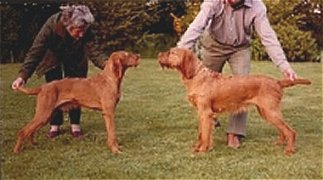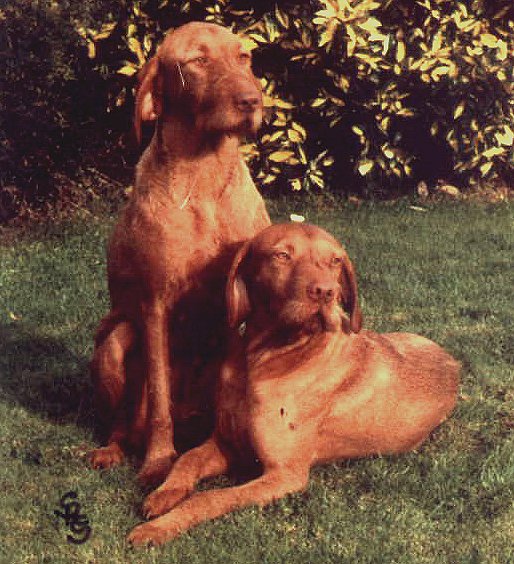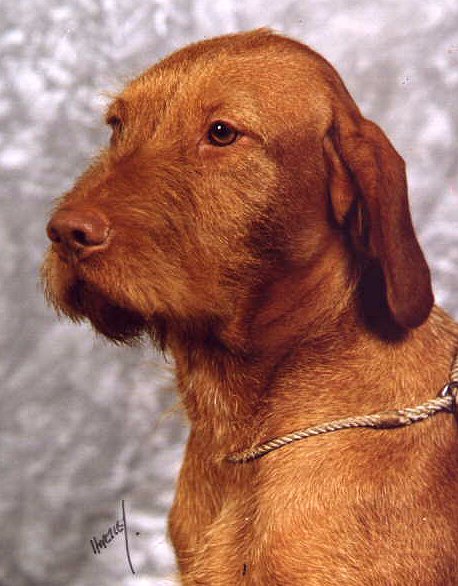History of the Hungarian Wirehaired Vizsla
About the Breed
Home Page
About Me and the Dogs
View our dogs
History of the Breed in the United Kingdom
Shows at which the breed may be seen
The breed at work - Shooting
Falconry
Deer Stalking
Pictures of friends' dogs
Puppy rearing
Variations in Coat
General Information
Links to Other Gundog Sites
| Meeting the Hungarian Wirehaired Vizslas (or HWV for short) for the first
time? Well, you are in for a delightful surprise, as they are utterly unique,
very laid back, and family orientated but with an inbred sense of working
ability. Because of this they are now very popular on shoots, used in falconry
and deerstalking. They are also doing very well in obedience. In fact whatever you ask them to do – they will do it happily. In the show ring they are now getting very popular, although, due to still being on the Rare Breed register, a great many people have them as a second breed, but we have had as many as 50/60 in the show ring. There are over 850 Wires in the country with a good breeding programme going on plus a lot of imports, so the breed is steadily expanding. When you look at a Wire initially, one of the first things you notice are the kind and gentle eyes, a face with eyebrows & beard, the coat is wiry (obviously), close fitting and up to 1½ inches long with an undercoat, and the colour varies from golden sand right through to russet. The size of the dogs is 23 – 24½ “high and the bitches 21½” to 23” with a variance of less than 3 cms permitted. They are more robust that their smooth cousins and have a completely different breed standard from them. The history of the breed makes for interesting reading as it originates from the 1930s, when a dog was required with basically the same features as a smooth Vizsla, but more resistant to cold weather conditions. The work towards this new breed was initiated by Vasas Jozsef and soon after he was joined by Greszarik Laszlo. They mated two Hungarian Vizsla bitches (Zsussi and Csibi) with a totally brown German Wirehaired Pointer (Astor von Potat). After various selections and further work, the first exhibition wire was born and called Dia de Selle. In 1943 Vasa Jozsef requested the Hungarian Vizsla section to assist in breeding; there seems to have been a lot of ‘Ums and Ahs’ but finally it was agreed and wirehaired vizslas were allowed to have non-official pedigrees. As with all breeds World War 2 caused a lot of problems for the HWV, but steadily it improved after the war and in 1966 the FCI finally acknowledged the Hungarian Wirehaired Vizsla as an independent breed. In 1992 the first breeding Wires came into the UK, imported from Hungary; now they are being imported from all round Europe and the breed has never looked back. People just love them for their loyalty, intelligence and affection, as a pet, for working or showing - whatever… Once someone owns one they are ‘Wired Up’ for life! |
||
| ……………… | ||
| The creation of the wirehaired Vizsla started in the 1930s. It was noticed that some Vizslas had thicker coats which gave them better protection in cover and water. One of these thicker coated bitches was crossed with a German Wirehaired Pointer. The breeder who did this was Mr. Vasas Jozsef. He tried two such matings with the same dog and different bitches. After this Mr. Gresznaryk Laszlo, the owner of the Selle kennels (called the Father of the wirehairs), continued the breeding with a dog and bitch from the first matings: Csabai Lurko x Csabai Lidi - Dia de Selle (1942) Dia de Selle is known as the mother of the breed. From 1942 onwards is a grey area in which no registrations were found. In the mid-Fifties registrations started again. It is known that they bred in a yellow Pointer (Hertha Pointer) at some stage and also the Irish Setter. In the late Sixties/early Seventies a Pudel Pointer was brought in, possibly earlier but no registrations were found. Although, again, no registrations have been found, it is almost certain a Braque, probably Hannoveraner was used in the creation. This information was kindly provided by Erwin Hoogenveen (Holland) History of the Breed in the United KingdomIn the late 1970s a bitch, ARANYOS TISZU DUDAS (Zloty) was imported by Douglas and Carol Appleton. This bitch was later transferred into the ownership of David and Mic Layton. In 1983 a dog, BOROSTYANKO GULYAS OF CARRIGTEMPLE was imported by the Appletons as a mate for Zloty. Unfortunately she never conceived. The Appletons took the dog back abroad with them when they went to live in France.
We then had to wait until 1991, when Anna Coombe and Sheila Gray imported ABAFIA MAYA (bitch), born 29th April, 1990, and AMOR (dog), born 3rd November, 1989. They then produced the first litter in this country on 19th March, 1992. There were nine puppies. Amor became ill and died before another litter was possible.
Maya (seated) and Amor The next import was HESTIA DU DOMAINE SAINT HUBERT, also owned by Anna and Sheila and now owned solely by Sheila. Then came ABAFIA VEZER AT CASTLEFIELD, imported by Anna Coombe and Josephine Vinovich, and he sired the second litter out of Abafia Maya. After that, Jean Robertson imported in 1994 KECEL HATSAGI SIMI (dog) and in 1995 Kevin and Julia Bingham imported ARANY MEZO BURNY. Since then, there has been a steady importation of "Wires" and the breed continues to grow.
|


